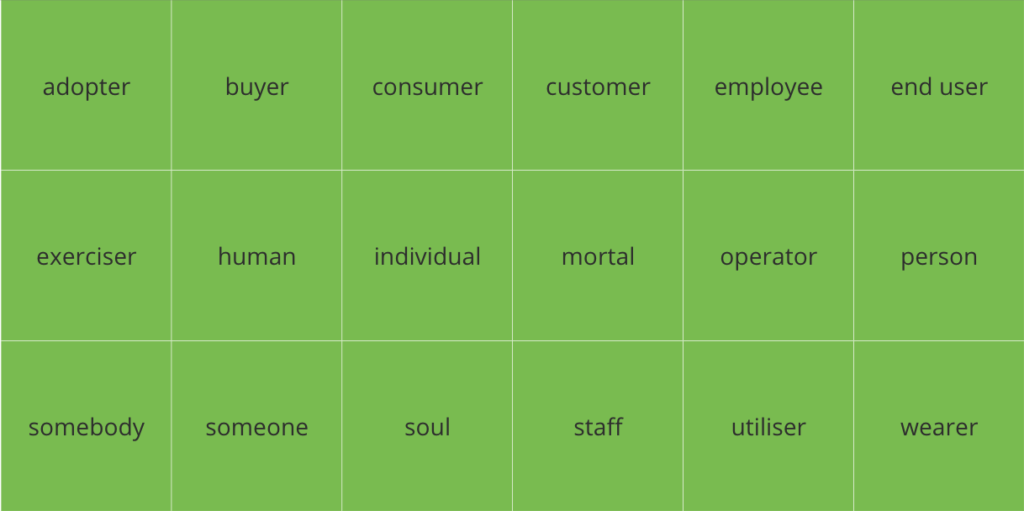Throughout my time in the user experience (UX) industry, I always understood that the fundamental plan was to ensure that technology was easy and straightforward to use. That content on websites and within software was clear and written with the end user in mind. That navigation was clearly structured and button and link labels were in plain English.
Unfortunately, something seems to have happened. UX seems to have been taken over by abbreviations and jargon. And it feels like this is affecting its understanding and acceptance outside of the UX arena. After speaking to people about user experience at countless networking breakfasts and lunches, it seems like outside of the UX world, there is still limited understanding regarding the benefits of employing UX methodologies.
Drowning in jargon and abbreviations
It can be difficult finding your feet within the world of user experience. Adjusting to the terminology used for job roles, articles and networking can sometimes leave you feeling overwhelmed and less than comfortable. It can feel like you’re drowning in abbreviations and jargon. Even for someone who has been immersed in the industry for a considerable amount of their adult life. Countless different job titles leave anyone outside of the UX world confused – and those inside wondering what job they are currently doing.
Am I a UX Researcher, UX Consultant, UX Designer, Usability Analyst?

Am I a UX unicorn?
Or am I a unicorn and all of the above? Outside of the UX world, these titles do not mean a great deal. However, if you mention the term user testing instead of user experience or UX, then there is a glimmer of understanding. For example: “Oh, you get people in to test websites, like UAT.”
Is user testing part of UAT?
The term user testing appears frequently in conversations with those both external and within the UX industry. So where did this come from? Conducting a usability evaluation was always the term used when I began my career as a usability analyst. This was used when gathering participants to understand how a product or service was meeting its user focus brief.
In addition to the Usability Team, there was a UAT Team to conduct user acceptance testing. This was being carried out to check software before being rolled out nearer the end of the process lifecycle, not at the beginning or during the development lifecycle. The confusion could be caused by both techniques using the term user.
There is confusion for many businesses as to what UAT and UX are and how they differ. Some see usability evaluation as a type of UAT and this is why sometimes UX methodologies are thought to be aspects of work which are brought in at the end of a project. For many, this could be because user testing is the most well-known.
Testing the product and not the person
Once you explain what can be gained by introducing UX as a part of a project lifecycle, it is much clearer to people how this could help their business and ultimately their customers and staff. However, the use of the term user can cause confusion. What is the difference between UAT and UX? More specifically, what do we mean by user testing versus usability evaluations?
I have always struggled with the use of the terms user evaluation or user testing. This is more damaging to the gathering of insights in UX than just using the term user to describe a range of people who are utilising a product or service. Is the term user the most appropriate one to use? And is user testing the correct way to describe the gathering of insights from people regarding technology and products?
If you type in user testing into Google or any other search engine, you will come across a multitude of sites and companies who use the term user testing. Some only use this as a keyword to guide potential businesses into their website. Afterwards, they explain the process using usability evaluation or usability study. However, there are other businesses who provide user testing laboratories or carry out user testing.
Of all the explanations and the striving to use words which people outside of the industry will identify with, the one term which has always left me cold is user testing. Especially when used to describe the method of engaging people to evaluate a product or service. This is not testing the user or person. This is getting the person to evaluate the product or service. Two completely different things!
The impact of UX
So how do we change this? Clarity of terms is one key aspect to address. But also the identification of where UX fits – not just within a singular project but its wider impact on a whole business, its employees, its external customers, and the wider community.
Excellent design and implementation can cause a ripple effect within a wider range of people – not just a target audience which it was initially designed for. Take the improvement of a restaurant ordering system, for example. This will not only impact the employees who are using it every day. It will also impact the customers, chefs, management, and others who do not have direct contact with it.

The improvement of a restaurant ordering system will impact far more people than those in direct contact with it.
This is the impact of UX, this is why the simplification and clarification of terminology are needed: to enable a clear understanding of what we mean by users and what UX research aims to explore.
Shifting the focus away from the person
Evaluations and testing are methods used in UX to gather an understanding of a product or service. How is it used? How does it benefit and fit with whomever the end user/customer/employee is? The person evaluating the product/service is not being tested. So why do some still label it user testing? It is usability testing or my preferred usability evaluation. These terms remove the emphasis on the participant and clearly show that the participant is not the main focus.
Even at the beginning of my career, I was always a little bothered by the term user. So I tried hard not to use it in my reporting. However, this proved very difficult: the term customer was not always appropriate, especially for the evaluation and reporting on Intranet sites and other internal software. So this became the issue of what terms do I use and where is the correct place to use them.
Unless I was reporting or talking about insights which were not gained from an evaluation, I found the word participant to be really useful. The term participant was a comfortable fit when writing evaluation scenarios and recruitment screeners. I felt that I was directly focused on and speaking directly about the people who had attended UX research sessions.
Another reason to adopt a general term is to ensure the anonymity of the participants. Although gender, age, and other requirements are necessary during recruitment and reporting, the participant’s name is not. The adoption of a blanket term, then, enables all participants to be treated without prejudice during the reporting process and helps to reduce bias.
Distinguishing between audiences
I needed to be able to distinguish between those people who were in the evaluation group and the wider audience. However, using different labels within a feedback report made the report feel cumbersome and confusing. Also, it proved more difficult than I thought.
Exploring the definitions of words is always a good place to start, so here are the definitions for the terms user, participant, and customer.
User: a person who uses or operates something.
Participant: a person who takes part in something.
Customer: a person who buys goods or services from a shop or business.
I then began looking for variations of these words to try and identify other terms which could replace user. The results included:

User is not a derogatory term
It is clear to see there are a number of available terms. But they do not provide an adequate description of the wide range of people who would be interacting with the products and technology that are being evaluated and explored. Many of the terms are specific and are more suited to use to identify a target group. This halted my rush to try and change the whole UX world and the use of the term user.
I then began to think of a different way of addressing the use of the term user. In the user experience arena, the term user is not derogatory. Its wider use outside of UX, however, conjures up negative images. And this could explain the reason for the exploration of other terms to describe those that interact with technology. But in reality, the word user is not to blame. Rather, the environment and social connotations of the word have affected its interpretation.
The label depends on the context
So, the next question is which term to use where. Having decided that, actually, user is not a term which should be relegated to the UX broom cupboard, we can look at the terms participant and customer. Both terms are heavily used when reporting in UX. Often, it is difficult to identify when to use them or whether both can be used in the same report or feedback.
After having mulled over these issues again and again whilst writing reports, I came up with a cunning plan to guide my use of the terms.

“I’ve got a plan so cunning, you could put a tail on it and call it a weasel.” – Rowan Atkinson as Edmund Blackadder
I broke my thought process down like this:
- User(s): to be used to refer to a wide range of people who were not deemed as customers of a service or product.
- Participant(s): to be used to describe people who were involved in a usability evaluation or other UX research study. This focuses the feedback and highlights the insights as coming from the people directly involved in the evaluation or study and not the wider customer or user group.
- Customer(s): to be used to identify actual customers of a product or service.
- Employee(s): to be used if the product, service, or technology is being used within the specific target audience’s workplace.
We are all users
The understanding I have gained from exploring the use of terminology and wording in UX is this:
As long as the human is identified as being the provider of insights and understanding and the products, services, and technology are always the items under scrutiny, then the term user is still a valid term to describe all of us.
My overarching thought process and my reason for working in UX are to understand the emotional and physical impact that technology has on humans. This can only be done by involving people in all aspects of the research and design process. By understanding how to meet our needs as humans first and foremost – rather than just consumers and users. So perhaps we shouldn’t focus on just the user experience (UX) or the customer experience (CX). Perhaps we should be looking to work within the realms of human experience (HX).
As a UX researcher, I make sure that I never use the term user testing. After all, the users are not our objects of study. Instead, their knowledge and insights help us understand how to provide a more balanced and informed route into adaptable and accessible technology. The term usability evaluation provides a clear identification of the process that is at work here.
We are all users of technology, users of the environment, and of life itself. So I am happy to be classed as a user of a product – as long as I am not being tested or scrutinised.

